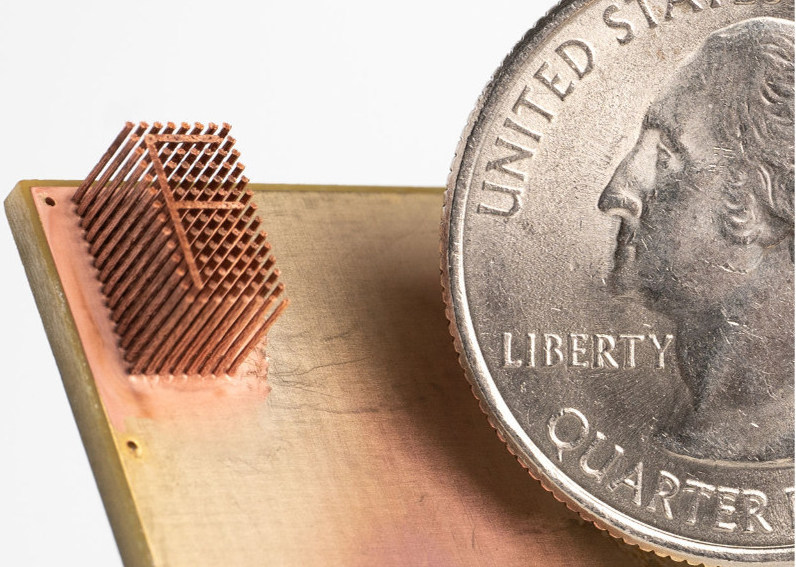Electrochemical additive manufacturing company Fabric8Labs has announced the close of a $50M Series B investment.
This round was led by New Enterprise Associates (NEA), with participation from existing investors, including Intel Capital, imec.XPAND, SE Ventures, TDK Ventures, and Lam Capital. The new funds will be employed to expand the company’s proprietary Electrochemical Additive Manufacturing (ECAM) technology and set up a pilot production facility.
“We are thrilled to have NEA’s support in executing our vision,” said Jeff Herman, Fabric8Labs CEO, and Co-founder. “It is critical to have partners that are aligned with our mission to fundamentally shift manufacturing with a sustainable, additive manufacturing approach; and we have been fortunate to surround ourselves with a team of top-tier investors.”

How does Fabric8Labs plan on using this investment for ECAM?
“ECAM stands out as truly differentiated among the sea of approaches to additive manufacturing,” said Greg Papadopoulos, PhD., Venture Partner at NEA. “You can avoid expensive post-processing, easily build complex things at micron-scale, print directly on your existing substrates, and do all of this at scale with, by far, the lowest energy — and thus carbon — footprint. We’re thrilled to partner with Jeff and the Fabric8Labs team on this revolution for additive manufacturing.”
Fabric8Labs claims that metal additive manufacturing has experienced rapid development over the past decade, with an average compound annual growth rate (CAGR) of 27%. However, due to the limitations of powder-based thermal processes and feedstocks, which drive high costs, inadequate repeatability, and highlight resolution limitations, the implementation of metal AM for high-volume manufacturing has been limited. ECAM, on the other hand, is built at the atomic scale from a water-based feedstock consisting of dissolved metal ions. Complex, internal features, micron-scale feature resolution, high-purity materials, and quick scalability to assist mass manufacturing are all possible with the electrochemical approach.
ECAM is particularly qualified to produce an ultra-high resolution, pure copper parts that can be explicitly printed onto temperature-sensitive substrates like PCBs, silicon, or existing metal parts. This functionality occurs at a time when electronics firms are searching for enabling technologies to resolve power density, thermal management, sustainability challenges, and device form factor. ECAM enables the creation of optimized designs that meet and surpass the increasingly strict performance standards in end applications like high-performance computing (HPC), data centers, electric vehicles, wearables, RF communications, and a variety of consumer electronics products.
ECAM is ecologically responsible and sustains green initiatives in addition to offering manufacturing capabilities that enhance customers’ technology roadmaps. ECAM decreases greenhouse gas emissions by more than 90% when compared to other additive technologies and conventional manufacturing. Customers’ implementation of ECAM across a broad range of market opportunities has been expedited by the “winning combination” of functionality, cost performance, and sustainability.
“The potential of Fabric8Labs’ novel technology is undeniable and we believe ECAM is suited to support a wide range of applications across the electronics value chain,” said Jennifer Ard, Managing Director at Intel Capital. “As the team works to scale their offerings, they’ll be able to deliver value across multiple business units for their customers, furthering their value-add.”
Furthermore, Fabric8Labs is also working on micro-mechanical parts and medical device applications. These applications leverage the power of ECAM’s inherent benefits to create extremely fine, advanced structures and high-performance alloys. As the company grows, ECAM will allow ultra-high-resolution applications like sensors, enhanced surgical tools, MEMs, and diagnostic equipment.

Electrochemical 3D printing
Previously, Lawrence Livermore National Laboratory (LLNL) researchers began employing 3D printing to create flow-through electrodes (FTEs) for electrochemical reactors, attaining reactor-improved performance of up to 100x. The LLNL team was capable of 3D printing customized porous electrodes made of graphene aerogels utilizing direct ink writing. The printed structures were critical for a wide range of electrochemical reactions, including the transformation of CO2 and other molecules into effective energy products.
Elsewhere, an electrochemical-based metal 3D printing technique was invented by a group of researchers from the University of Texas at Dallas Department of Mechanical Engineering. This method, known as localized pulsed electrodeposition (L-PED), allowed the team to control the metal microstructure in real-time throughout the printing process. L-PED, which is also free of post-processing, improves the electrical and mechanical characteristics of 3D printed pure crystalline metals by adjusting process parameters.
What does the future of 3D printing for the next ten years hold?
What engineering challenges will need to be tackled in the additive manufacturing sector in the coming decade?
To stay up to date with the latest 3D printing news, don’t forget to subscribe to the 3D Printing Industry newsletter or follow us on Twitter, or like our page on Facebook.
While you’re here, why not subscribe to our Youtube channel? Featuring discussion, debriefs, video shorts, and webinar replays.
Are you looking for a job in the additive manufacturing industry? Visit 3D Printing Jobs for a selection of roles in the industry.
Feature image shows Fabric8Labs’ technology reportedly yields structures with “superior feature resolution.” Photo via Fabric8Labs.



